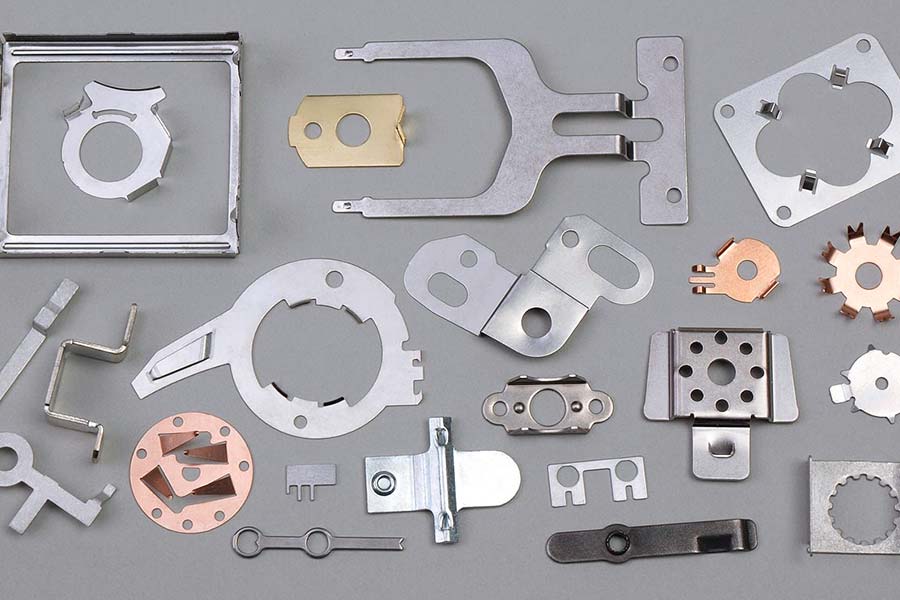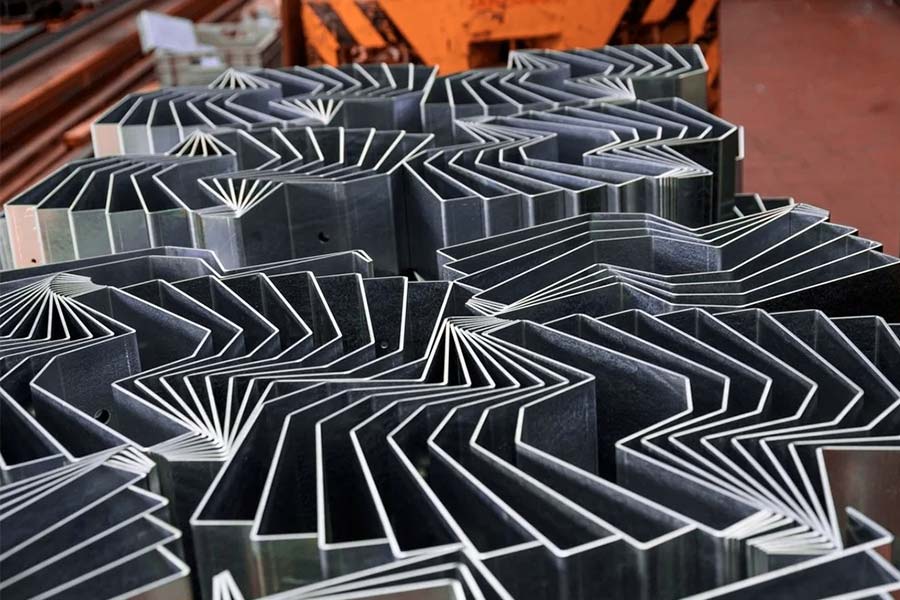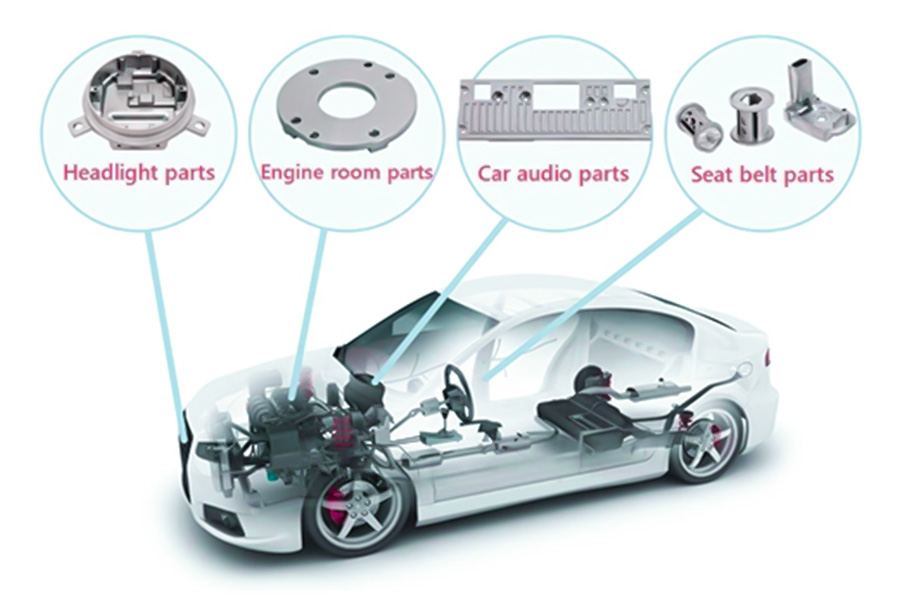Le principe central de l'estampage métallique est d'utiliser un moule à haute précision pour appuyer , plier ou étirer un blanc métallique dans une forme spécifique, avec les avantages d'une efficacité élevée, d'une faible consommation et d'une bonne consistance.
estampage?
1. précision et cohérence
Metal Stamps Moule adopte la technologie d'usinage CNC, la précision de tolérance ± 0,005 mm, . The consistency of the product in the mass production process is very haut.
2. Productivité
Le moule de timbres métalliques peut être commuté rapidement, et avec l'aide de pressions automatisées, un appareil peut produire des centaines de pièces par heure, ce qui les rend particulièrement , comme les enveloppes d'appareils domestiques et les composants structurels des produits 3C.
3.Cost Avantages
Le moule peut être réutilisé des milliers de fois, dilue les coûts unitaires au fil du temps et atteint un taux d'utilisation de matériel sur 85%. Compared with CNC cutting, it reduces waste, especially Pour les matériaux de grande valeur tels que les alliages en aluminium et l'acier inoxydable.
4.Capacité de traitement de forme complexe
Metal Tampons Soutien des conceptions personnalisées industries en ajustant les paramètres de moisissure. 1.Design et moule et moule et moule et moule Faire estampage?
2. Sélection et coupe des matériaux
Dans l'équipement d'estampage automatique, l'emboutissage, la flexion, l'étirement et d'autres processus sont achevés en un seul estampage sur le processus métallique.
4. traitement de surface et inspection de qualité
Après l'estampage, fournissez le retrait de la bavure, le placage, la pulvérisation et d'autres services à valeur ajoutée.
5. Production durable
équipement?
1. Hydraulic stamping equipment: Driven by hydraulic system, it is suitable for high-precision stamping of large metal sheets and is commonly used in the production of automobile overlay or heavy machinery structure.
2. Équipement d'estampage hydraulique: Le système hydraulique offre une pression stable, adaptée à l'estampage des travaux métalliques qui nécessitent une haute précision, comme la formation de poutres d'automobile et de structures de machines lourdes.
3. Presses d'estampage mécanique: entraîné par un mécanisme de canne de vitesses, Convient pour une grande production de métaux à haut débit.
5.Servo stamping presses: Utilisation des servomoteurs pour contrôler la course et la pression avec précision, il convient à l'estampillation du traitement métallique de l'énergie en aluminium, des alliages de magnésium et des autres matériaux légers, et peut économiser plus d'énergie à 30% que l'équipement traditionnel que l'équipement traditionnel.
6. Machines de cisaillement: Il est spécialement conçu pour couper les feuilles de métal en ligne droite et est souvent utilisée à l'avant d'une ligne d'estampage pour traiter des bobines ou des plaques de grande taille. 7. bend machine: Il s'agit d'une méthode couramment utilisée dans le traitement structurel pliant ou 3D des feuilles de tôles pour atteindre la flexion et la formation de la moisissure. 8. Fine Blanking Prestes: Grâce à la combinaison de la technologie d'estampage et de cisaillement, un processus métallique d'estampage gratuit et de haute qualité, Applied to Gear Gears composants. 9. Systèmes d'estampage assistés par laser: L'efficacité de traitement de l'estampage du métal est améliorée par la combinaison de la précut et de l'estampage au laser.
1. Principes du processus 2. Dépendance des équipements et des moisissures 3. Degré de déformation du matériau 4. Effectif et coût
5. Qualité de surface In short, metal stamping is a subtractive+plastic forming technology driven by metallic stamp, while sheet metal fabrication is a combination of cutting and bending, which complement each other to meet the needs of different industries. 1.Car lightweight components 2.Aerospace heat resistant components 3.Consumer electronics cooling module 4.Medical devices 5.New energy storage systems 1.Automotive industry This is definitely the biggest beneficiary! Think about it, how many things on a car are stamped out of metal? Doors, roofs, hoods, trunk lids and other shells (body coverings), the supporting skeletons (frames, chassis parts), and various brackets, brackets, fuel tanks, exhaust pipe parts, etc., are too numerous to count. Stamping allows automakers to produce these key parts quickly and cheaply, and with stable quality. Now everyone is pursuing lighter and more fuel-efficient cars, and materials such as high-strength steel and aluminum alloys are also mainly handled by advanced stamping technology. 2.Home appliance industry Many of the shells of home appliances such as refrigerators, washing machines, air conditioners, microwave ovens, ovens, and range hoods are stamped out of metal plates. Stamping ensures that these parts have regular shapes and accurate sizes, making home appliances look beautiful, easy to install, and durable to use. 3.Electronic products industry Computer cases, laptop shells, server cabinets, metal brackets inside mobile phones, connectors, heat sinks, metal shells and chassis of various electronic devices, all of which require very precise metal parts. Stamping technology, especially precision stamping, can efficiently and in large quantities produce these small parts with high size requirements and complex shapes, which is essential for the manufacture of electronic products. 4.Industrial equipment and machinery industry Shells, protective covers, bases, brackets, gears, sprockets, conveyor belt parts, motor housings, pump body parts, etc. of various machine equipment. Stamping provides a large number of sturdy and reliable structural parts and functional parts for these industrial equipment, and is one of the basic links in equipment manufacturing. 5.Other fields 1.High temperature stability Leaves need to work in a high temperature (800°C to 1100°C) gas environment for a long time, the material needs to resist creep, oxidation and low thermal expansion coefficient. 2.Mechanical strength and fatigue life limitations 3.The contradiction between lightweight and specific strength 4.Material processability limitations 5.Corrosion resistance and oxidation limitations Core advantages of JS material library 1.High-strength and lightweight materials 2.Corrosion resistant and high-temperature resistant materials 3.Precision processing specialized materials 4.Environmentally friendly and sustainable materials Material solutions for the automotive industry Differentiation in JS Metal stamping, as the cornerstone process of modern industry, has permeated dozens of fields such as automobile, electronics, healthcare, aerospace and so on. Regardless of the type of complex and irregular structures, stamp metal technology achieves one-off molding of complex structures by balancing strength, precision and cost efficiency through the synergy of high-precision molds and presses. In the future, as smart factories and green manufacturing advance, stamp metal will continue to define the limitless possibilities of industrial manufacturing in an efficient and low-carbon manner. The content on this page is for general reference only. JS Series makes no express or implied warranties regarding the accuracy, timeliness, or applicability of the information provided. Users should not assume that the product specifications, technical parameters, performance indicators, or quality commitments of third-party suppliers are completely consistent with the content displayed on this platform. The specific design feature, material standards, and process requirements of the product should be based on the actual order agreement. It is recommended that the purchaser proactively request a formal quotation and verify product details before the transaction. For further confirmation, please contact our customer service team for professional support. JS is an industry leading provider of customized manufacturing services, dedicated to providing customers with high-precision and high-efficiency one-stop manufacturing solutions. With over 20 years of industry experience, we have successfully provided professional CNC machining, sheet metal manufacturing, 3D printing, injection molding, metal stamping and other services to more than 5000 enterprises, covering multiple fields such as aerospace, medical, automotive, electronics, etc. We have a modern factory certified with ISO 9001:2015, equipped with over 100 advanced five axis machining centers to ensure that every product meets the highest quality standards. Our service network covers over 150 countries worldwide, providing 24-hour rapid response for both small-scale trial production and large-scale production, ensuring efficient progress of your project. Choosing JS Team means choosing manufacturing partners with excellent quality, precise delivery, and trustworthiness. 1.What is the definition of metal stamping? The process of manufacturing parts by applying pressure on metal materials by mould and press is characterized by high precision and high efficiency. 2.Key points of stamping mold design? In order to optimize processing cost and production efficiency, attention should be paid to reasonable structure, material strength and abrasion resistance, accurate control of suitable clearance and slope removal, and ensure stamping accuracy, mold life and operation safety. 3.What are the characteristics of aerospace stamping parts? High-strength and lightweight materials (titanium alloy/hyperalloy), precision molds, multi-process stamping are required, with high temperature resistance, high pressure resistance, micrometer level tolerances, lightweight structure, etc. 4.What are the application fields of metal stamping? Widely used in automotive, electronics, home appliances, medical, aerospace, new energy, construction, manufacturing structural components, precision parts, lightweight components and other fields.
JS Expert en prototypage rapide et fabrication rapide Spécialiser dans l'usinage CNC, l'impression 3D, la coulée d'uréthane, l'outillage rapide, le moulage par injection, la coulée de métal, la tôle et l'extrusion. Étiqueter:
Fabrication?
Éléments de comparaison
Embarcage métallique
Coût unitaire (production de masse)
≤ 0,5 $ (lors de la production de 100 000 pièces par an
2-5 $ (petit lot).
Temps de production à une pièce (secondes)
0,5-5 (l'estampage à grande vitesse peut atteindre moins de 0,1 seconde).
30-300 (selon le processus).
coût du moule (dix mille $)
5-50 (plus haut pour les moules complexes).
0,1-5 (certaines pièces ne nécessitent pas de moules).
Économie de lots minimum
1-100 pièces.
Cycle de production typique
Le développement de la moisissure prend 2 à 4 semaines et la production de masse commence à partir de 1 semaine.
Développement sans moisissure, le traitement à une pièce unique prend 3-7 jours.
Taux d'utilisation des matériaux
85% -95% (la moisissure progressive réduit les déchets).
70% -90% (perte de coupe + matériau d'angle).
Coût d'élimination des déchets
High (avec beaucoup de restes, nécessitant un traitement supplémentaire).
What are the applications of combining composite materials with metal stamping?

Which industries does metal stamping help?
What are the restrictions on stamping materials for engine blades?

How does JS's material library match the needs of the automotive industry?
Industry demand
JS material solution
Automotive industry adaptation cases
Lightweight
Aluminum alloy+topology optimization design.
A new energy car company has lost 3.2kg of battery pack weight and increased its range by 15%.
Wear resistance
POM+DLC coating.
Automatic transmission valve body lifespan has been extended to 800,000 kilometers.
Electromagnetic shielding
Nickel plated graphite fiber.
the onboard ECU improved anti-jamming by up to 40dB.
Rapid iteration
3D printing nylon prototype.
New air conditioning vents have a 60% reduction in the validation cycle.

Summary
Disclaimer
JS Team
For more information, please visit the official website: jsrpm.comFAQs
Resources
Blogs connexes
Précision vs durabilité: 5 compromis critiques en ingénierie d'estampage métallique
Empilement métallique Essentials: production de masse pour l'automobile, l'électronique et les consommateurs durables
Processus d'estampage des métaux: Quel type est le meilleur pour la conception de votre produit?
Matériaux d'estampage en métal décodés: une durée de vie de 50% plus longue commence par ce guide en alliage
Empestation en métal pour les débutants: 5 étapes de processus, choix de matériaux et pièges à éviter
Qu'est-ce que l'estampage du métal?

Criticism
Featured Blogs





